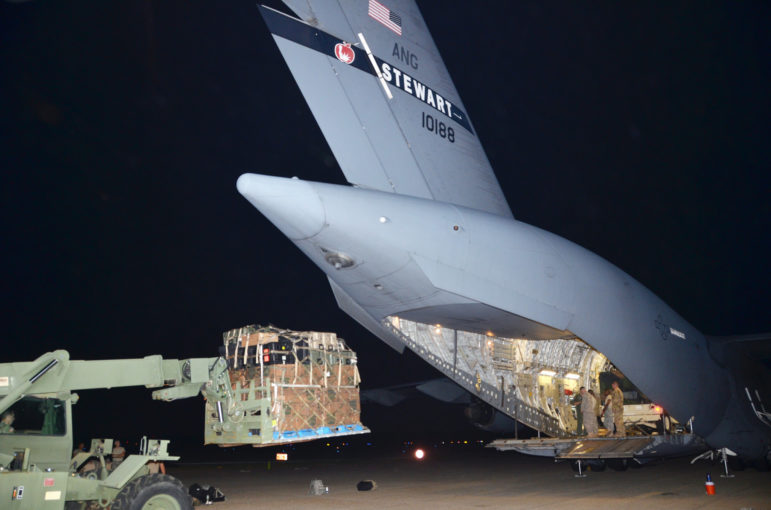
Capt. Mark Getman, New York Guard State Defense Force.
New York National Guard soldiers load equipment for a recovery mission to Puerto Rico in late September.
Eight weeks since Hurricane Maria dealt a punishing blow to Puerto Rico, millions on the island are still suffering. Twenty five percent lack access to clean drinking water. Fifty five percent lack electricity. Food and medicine remain scarce in remote parts of the island.
For New Yorkers this is not a distant tragedy—it is a local crisis. Our city is home to 800,000 Puerto Ricans. The economic and cultural ties between New York City and La Isla del Encanto run deep.
The ties are personal for my family. My wife Ivelisse was born and raised on the island, and her parents and extended family still live there. Their home in Guaynabo was hit hard by the storm, and two months later power has still not been restored.
Despite the persistence of the island’s struggles, the federal response—late, insufficient, and poorly coordinated to begin with—is already being scaled back. The general in charge of the relief effort has just announced he will be departing from Puerto Rico. Tragically it appears that President Trump is already fulfilling his threat that the federal forces can not stay in Puerto Rico “forever.”
We can never undo the damage done to the morale of Puerto Ricans when President Trump insulted, attacked, and disregarded them during the difficult early days of the post-Maria crisis. But we can—and must—fight to ensure a robust, sustained federal response.
Recovery in Puerto Rico will not be a short-term project, and it won’t be cheap. Five years after Superstorm Sandy New York City is still rebuilding. The federal government has spent over $120 billion on recovery from Katrina so far—and 12 years in, the spending there continues.
By comparison, thus far congress has allocated only $4.9 billion in aid for Puerto Rico. And that relatively modest amount has been offered as a loan, not a grant. Estimates of the full cost of rebuilding are upwards of $80 billion.
Puerto Ricans have responded with incredible grit, stoicism and ingenuity to the crisis, as I witnessed first hand on my trip there last week. Regular people all over the island have found ways to survive and support each other under the most difficult of circumstances. New Yorkers have done their part to support our brethren on the island, donating millions to relief funds and sending countless tons of supplies to the island.
But private donations and bootstrap ingenuity will never be sufficient for rebuilding the infrastructure of an island of 3.5 million. The federal government is the only possible source of resources on that scale. The state of Puerto Rico’s power grid, water systems, and road network is comparable to that of a war-torn country. And history provides a successful example of how the United States should respond in such circumstances.
Puerto Rico needs a Marshall Plan.
The U.S. rebuilding effort in Europe after World War II cost $132 billion, adjusted for inflation. This investment paid off many times over for America and the world, as former war-torn countries emerged as successful industrial democracies. A robust investment in Puerto Rico today would help ensure that the island doesn’t just stabilize, but that it establishes a vibrant economy that would enable it to tackle the long-term challenges it faced even before Maria.
Puerto Ricans, despite being U.S. citizens, and despite having served and died in every American war for the past 100 years, have no vote in Congress and no vote for president. It is therefore incumbent on those of us on the mainland to use raise our voice on their behalf.
A nation which rebuilt half of Europe in 1947 can certainly do the same for 3.5 million of its own citizens. Puerto Ricans desperately need our the federal government to make a comprehensive, visionary and sustained commitment to rebuild. We’ve done it before. We can—and must—do it again.
A version of this piece also appeared in El Diario.









7 thoughts on “CityViews: Puerto Rico Needs A Marshall Plan”
Pingback: Medtronic profit fell 7 percent after natural disasters affected plants in Puerto Rico, California – Susan Heasley
Pingback: After CNN investigation, Puerto Rico asks funeral homes to help identify hurricane deaths – Wanda Posner
I agree. Coincidentally, I’ve begun reading a fat book published this year about the Cold War, which book of course includes some parts about the Marshall Plan after WWII. I wish I were invited to contribute what ideas I can on the outline level in the planning area, since it’s somewhat related to my college major (Geography) and career aspirations. I’ve suggested a few ideas early on, but have gotten no responses. Most pols are more concerned with preserving the power structure than anything else.
P.S. The evening before Hurricane Maria hit PR, I wrote lyrics for this to the tune of the iconic song in “West Side Story.” I’ve shared this, too. My best friend liked them.
Pingback: The Pentagon's hurricane relief effort in Puerto Rico is nearly over, but these missions remain - Ditmatrix
Pingback: The Pentagon's hurricane relief effort in Puerto Rico is nearly over, but these missions remain - Afriya FM
Pingback: The Pentagon’s hurricane relief effort in Puerto Rico is nearly over, but these missions remain – Wanda Posner
Pingback: The Pentagon's hurricane relief effort in Puerto Rico is nearly over, but these missions remain